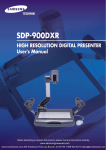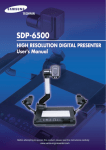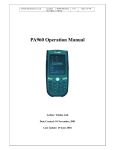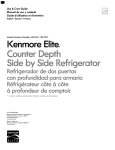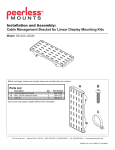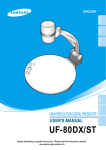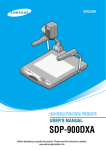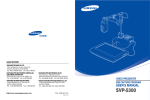Download Samsung SDP-900DXA Specifications
Transcript
SDP-900 Special features Thank you for purchasing this product. This product is a high resolution video presenter that can project all kinds of data on a PC monitor, a TV, or a projector with simple manipulations. 12X zoom lens (can be used for the materials with sizes from B4 to film) Special features By adopting 12X super optic angle zoom lens, it is possible to shoot all materials from the size of a film to B4 size. Adopted 850,000 pixel CCD By adopting 1/2 inch PS type CCD, high resolution and excellent color reappearance are realized. Can control USB and RS-232 By using USB, it is possible to view or store the image in a PC and control the functions of the set. Also it is possible to control the set by using RS-232C port. Output modes from VGA to XGA It supports various output modes from XGA to VGA that it can be connected to all kinds of projectors. remote controller is a standard feature remote controller is supplied as a standard feature for the product so that it can be manipulated from a distance. Thus it is very convenient during a conference. TV output mode By adopting TV output mode, monitoring and conference data can be recorded through VTR. Page 2 Features Various image control Features Digital features on your Video Presenter provide useful and various image controls including: - Negative/Positive image conversion - Brightness and R/B color control - Image save/recall - Image freeze - Image divide Input source selection You can quickly switch between your computer presentation and your document presentation with the INT/EXT button on the control panel or on the remote controller. Custom user settings To avoid any interruption of presentation to reset the video presenter, you can preset up to 4 customized settings in the memory and simply recall it during the presentation. Page 3 SDP-900 Contents Product features and structure Safety precautions..................................................................5 Uses of video presenter .........................................................6 Supplided accessories ...........................................................7 Names and functions of each part ........................................8 Front side............................................................................8 Main control panel ............................................................10 Terminals at the back .......................................................11 On the remote controller ...................................................12 Contents Operation methods Set preparation......................................................................14 Connecting to output device ...............................................15 TV, PC Monitor or Projector..............................................15 Desktop computer.............................................................16 Computer ..........................................................................17 Microphone .......................................................................17 Using the presenter ..............................................................18 To see the image received from external device ..............18 To project an object on the video presenter .....................20 Adjusting your image ...........................................................23 Before requesting service Notes on operations .............................................................27 Storage...................................................................................28 Trouble shooting...................................................................30 Fuse and battery replacement .............................................31 Specifications........................................................................32 Page 4 Safety precautions 10. Never push objects of any kind through cabinet slots. Never spill liquid of any kind into the presenter. 11. Except as specifically explained in this User's Manual, do not attempt to service this product yourself. Refer all servicing to qualified service personnel. Opening or removing covers may expose you to dangerous voltages and other hazards. 12. Unplug the presenter during lightning storms or when it will not be used for extended periods. 13. Do not place the presenter and remote controller on top of heat-producing equipment or in a heated place, such as a car. 14. Unplug the presenter from the wall outlet and refer servicing to qualified service personnel under the following conditions: • When the power cord or plug is damaged or frayed. • If liquid has been spilled into the presenter, or it has been exposed to rain or water. • If it does not operate normally when you follow the operating instructions, or if it exhibits a distinct change in performance, indicating a need for service. • If it has been dropped or the cabinet has been damaged. Safety precautions Follow these safety instructions when setting up and using your Video Presenter: 1. Do not place the presenter on an unstable cart, stand, or table 2. Do not use the presenter near water or sources of heat. 3. Use the type of power source indicated on the presenter. If you are not sure of the power available, consult your dealer or power company. 4. Place the presenter near a wall outlet where the plug can be easily unplugged. 5. Take the following precautions for the plug. Failure to comply with these precautions could result in sparks or fire: Do not insert the plug into an outlet with dust present. Insert the plug firmly into the outlet. 6. Do not overload wall outlets, extension cords, or integral convenience receptacles. This can cause fire or electric shock. 7. Do not place the presenter where the cord can be walked on. It may result in fraying or damage to the plug. 8. Unplug the presenter from the wall outlet before cleaning. Use a damp cloth for cleaning. Do not use liquid or aerosol cleaners. 9. Do not block the slots and openings in the presenter case. They provide ventilation and prevent the presenter from overheating. Do not put the presenter on a sofa, rug, or other soft surface or in a built-in installation, unless proper ventilation is provided. FCC Compliance Statement This equipment has been tested and found to comply with the limits for a class A digital device, pursuant to part 15 of the FCC Rules. These limits are designed to provide reasonable protection against harmful interference when the equipment is operated in a commercial environment. This equipment generates, uses, and can radiate radio frequency energy and, if not installed and used in accordance with the instruction manual, may cause harmful interference to radio communications. Operation of this equipment in a residential area is likely to cause harmful interference in which case the user will be required to correct the interference at his own expense. Page 5 SDP-900 Uses of video presenter Conference Uses of video presenter Detailed information in a report, form, table, etc. as well as a three dimensional object, such as a model, can be projected on a screen clearly that all the participants can focus on the same topic during a conference. Thus it is very helpful for an effective progress of a conference. Education It can be used as an audiovisual tool for printed materials, such as text books, as well as audiovisual materials, educational materials, and especially for students' art works. Medicine and science areas Advertisement and design areas It is possible to present various visual data including slides and X-ray film etc. at a medical conference or a doctors' association in the order of file. It is useful in design area where visualization is necessary. It is possible to project catalogs and slides, thus the effect of a job can be checked easily. Demonstration or exhibition By connecting to a large projector, it can produce dynamic images at a new product demonstration, an exhibition, or an event. Page 6 Supplided accessories When you unpack your Digital Presenter, make sure that you have all these components. Audio & C-Composite cable S-video cable remote controller Power cable Dust cover Adaptor lens and Lens cap PC Monitor cable USB Cable SDP-900 program RS-232C Reference etc. Supplied accessories User's Manual Diskette Program Manual Page 7 SDP-900 Name and function of each part Front side 1 Name and function of each part SD Sa mSu ng P- VI DEO 90 PR 3 ES 0 EN TE R 2 4 5 6 7 Page 8 1 Lens Can rotate to the front and back. SD Sa mSu ng P- VI DEO 90 PR ES 0 EN TE R SD P- 90 0 Main support 3 Main lock button Name and function of each part 2 Press to move the main support. 4 Lamp unit (Upper lamp) 5 Document plate (built-in light box) 6 Main control panel (see next page) 7 IR Sensor Page 9 SDP-900 Name and function of each part Main control panel The buttons on the main control panel can be found in the remote controller. These buttons perform the same functions. 1 Name and function of each part 1 POWER 2 FREEZE 4 ZOOM 10 4 5 6 Use this to freeze the image. AWC 6 3 Use this to turn the power on or off. 3 5 Page 2 7 7 MODE 8 INT / EXT 9 LAMP 10 IRIS Use this to control the color automatically. Use this to control the size of an object projected on the screen. 8 9 10 Use this to select the desired resolution for the video output device(PC monitor, projector) connected to this product. Use this to select internal or external image INT: to view the image on this product. EXT: to view the VGA output from another device such as a PC monitor or a projector by connecting it to this product. Use this to turn the upper lamp or light box on or off. FOCUS Use this to adjust the focus. APERTURE Use this to control the sharpness of the output image. Use this to control the brightness of the image by using the iris. Name and function of each part Terminals at the back 1 2 4 1 POWER INPUT TERMINAL 2 VGA VIDEO INPUT 1,2 3 Use this to connect the power cable. (100 - 240V, free voltage) Connect this to the VGA output terminal of another VGA output device. When external input is selected, the image is shown through the VGA out terminal. VGA VIDEO OUTPUT 1,2 Connect this to the RGB input terminal of a PC monitor or a projector. 6 8 7 9 Name and function of each part 3 5 10 6 AUDIO OUTPUT (LEFT/RIGHT) 7 AUDIO INPUT 8 RS-232C: COMPUTER CONNECTION TERMINAL Connect this to the audio output terminal of a TV or a VCR or speakers. The sound from an external AV device or microphone is heard through this. Connect this to the audio output terminal of a PC. Connect this to listen to the sound from another AV device. Use this to connect RS-232C cable. 4 USB: COMPUTER CONNECTION TERMINAL Use this to connect USB cable when transmitting image by USB port. 5 TV OUTPUT Connect this to the TV input terminal. Connect this to view the image projected on the TV screen. Even when the external input is selected, only the image on the main unit is displayed on TV output terminal. 9 S-VIDEO OUTPUT 10 MICROPHONE This is the video output terminal connecting to a TV that has S-video input terminal. Use this to connect the microphone to the main unit. Page 11 SDP-900 Name and function of each part On the remote controller Name and function of each part POW ER 1 2 INT 3 /EX T POS I/NE FOC GA US LAM P F 5 RED 1 + N 3 5 7 6 + 8 RTU R E FRE 14 15 IRIS EX IT IRIS NT SC PR ME 6 9 10 13 12 ES RE ET SAV LL E DIV IDE AC T 16 IVE SH IFT 12 VOL U TEL E L SAV E + /PA CA Page - EZE 11 - AW C APE WID E + - MO DE 4 E 2 4 7 8 BLU 17 1 POWER 2 INT/EXT Allows to choose the signal input to be displayed. 3 6 Stops current function and return to the normal mode. 15 RED/BLUE/AWC Adjusts the image color. R +/-: Adjusts the red color. B +/-: Adjusts the blue color. AWC: Adjusts color automatically. NTSC/PAL Switches Video output mode to NTSC or PAL. 16 FOCUS Allows to focus an object. F: Used to focus an object which is in the far distance. N: Used to focus an object being close. EXIT PRESET • Saves the customized user setting values. • Activates the preset user settings. 17 SAVE/RECALL • Saves the projected image into the memory of this unit. • Recalls the image from the memory. DIVIDE MODE Divides the screen to see both of the current image and the image recalled from the memory simultaneously on one screen or to see all the images in the memory on one screen. Allows to choose the resolution of the VGA output device connected to the Digital Presenter. SHIFT 8 APERTURE Shifts the recalled image shown in the divided screen from the left to right to see the hidden portion of the image. 9 FREEZE 10 VOLUME 11 12 WIDE/TELE 7 Controls the sharpness of the output image. Names and functions of each part 5 14 LAMP Turns the upper lamps and/or lightbox on or off. IRIS+ / IRIS• Opens iris to increase the brightness. • Closes iris to decrease the brightness. NEGA/POSI Switches for negative or positive film. 4 13 Turns power on or off. Keeps the current image on the screen. Adjusts the audio volume. • Enlarges the image size. • Reduces the image size. Page 13 SDP-900 Set preparation 1 Press the main lock button and raise the main support 2 Raise the lamp unit until it is convenient for use, and set it to the center of the document plate. Sam SD Sun g VID P-9 EO PR ES 00 EN TE R Set preparation SD Sa mS un g VID EO P-9 00 PR ES EN TE R 3 Adjust the angle of the lamps properly. Sa ung P-9 EO PR Remove the lens cap. ES Sa 00 EN TE P- 6 90 0 PR ES EN TE R 110V 14 un g VID P-9 PR 220V Page SD mS EO R SD Sa mS un g VI DE O Turn the lens area to face downward. SD mS VID 5 4 ES 00 EN TE R Plug the power cord in. Connecting to output device TV, PC Monitor or Projector SD SamS ung P- VIDEO 90 PRES 0 ENTE R Connect a TV, PC monitor or Projector to this presenter to display the projected image using the AV cables, S-video cable or PC monitor cable. If you use an optional microphone or if your presentation includes sound effects which is received from AUDIO IN jack, you need to connect the audio cable to AUDIO OUT jack. Connecting to output device Connection Connect to the VGA input terminal Digital Presenter PC monitor, projector, etc. Note Set the resolution mode of the main unit to the maximun resolution of the external device connected. Connect the yellow plug to the VIDEO OUT and white plug to AUDIO OUT jack. Connect the yellow plug to the video input and white plug to the audio input port. You may use 1or 2 jack. The signal from these jacks are equivalent. Or Digital Presenter If you have a TV or monitor equipped with S-video terminal, you can connect to S-video jack. Note If you connect to S-video terminal, you may obtain more clear image, but the signal from the external AV source(if connected) is not available on this terminal. Page 15 SDP-900 Connecting to output device Desktop computer SD SamS ung P- VIDEO 90 PRES 0 ENTE R Connecting to output device For SDP-900, connect a desktop PC using USB cable and install the supplied SDP-900 program. You can see the projected image on the PC monitor and control the image as a graphic file using the program. RS-232C connection is available for advanced user. If you connect a PC with RS-232C cable, you should set up your PC and make your own program to control the projected image on PC. Ask your dealer for further details. USB connection Digital Presenter Connect to the USB port on your PC, then install the supplied SDP-900 program. RS-232C connection Digital Presenter Connect to the RS-232C terminal on your PC. Note Page 16 RS-232C cable is not provided with the presenter. You can obtain one from your computer dealer. Connecting to output device Computer If you connect computer through VGA IN port, you can receive video signal from the computer. SD SamS ung P- VIDEO 90 PRES 0 ENTE R Connecting to output device Connection Connect to the VGA input terminal Digital Presenter Connect to VGA IN terminal using the VGA cable from the computer. VGA IN terminal is available. Connect to VGA port on the comnputer equipped with XGA, SVGA or VGA graphic card. Microphone To enhance the presentation with the presenter's voice guidance, use a microphone. Microphone is not supplied with this presenter. Use a microphone equipped with ø6.3. Page 17 SDP-900 Using the presenter To See the image received from external device 1 Set up your digital presenter properly. (See page 14.) SD Sam Sun P-9 g VID EO 00 PRE SEN TER Using the presenter 2 3 Connect the input device from which you want to receive the image and the output device on which you want tho see the image. (See pages 15 through 17.) Turn the power of the input and output device, and the digital presenter on. POW INT ER /EX T POS I/NE GA FOC US LAM P F RED 1 + N MO E + - DE 3 5 7 Note BLU 2 4 - AW C When the digital presenter is powered on, the upper lamps turn on. To turn it off, press LAMP button of the presenter. POW INT ER /EX T POS I/NE FOC GA US LAM P F RED 1 + N MO Page 18 3 5 - AW C 8 RTU R E + - DE 7 APE BLU 2 4 6 + Using the presenter 4 Choose the video source with the INT/EXT button of the presenter. POW INT ER /EX T POS I/NE FOC GA US P RED 1 + N T1 OU T Note 5 E + - DE 3 5 7 EX BLU 2 4 MO Using the presenter LAM F - AW C • Each time you press the button, the display shows EXT1 OUT, EXT2 OUT, INT OUT. • EXT1 OUT, EXT2 OUT View the image and sound from an external VGA output device through a PC monitor or a projector connected to the digital presenter. • INT OUT Choose this mode to see the image through the lens of the digital presenter. If NO EXT1 SYNC or NO EXT2 SYNC is displayed, check if the external input device is connected properly. Open the image on the computer. Now you see the image through a PC monitor or a projector. SD SamS ung P- VIDEO 90 PRES 0 ENTE R 6 If necessary, you can adjust the audio volume using the volume buttons on the remote controller. F RED 1 + N MO BLU E 2 4 + - 3 DE 5 7 - AW C 6 + 8 APE RTU R E FRE - EZE WID IRIS E EX IT NT SC /PA L IRIS - VOL U ME + TEL E P Page 19 SDP-900 Using the presenter To project an object on the video presenter 1 Set up your digital presenter properly. (See page 14.) SD P-9 Sam Sun g VID EO 00 PRE SEN TER Using the presenter 2 3 Connect to a TV, a PC monitor, a projector to display the image. (See page 15.) Turn the power of the output device and the digital presenter on. POW INT ER /EX T POS I/NE FOC US P RED 1 + N MO 3 E + - DE 3 5 7 BLU 2 4 AW C GA LAM F - Place the object on the lightbox, and adjust the head to face the object. SD Sam Sun P-9 g VID EO 00 PRE SEN TER Note Page 20 If there is no image on the TV, PC monitor or the projector check if the cable is properly connected, and press the INT/EXT button of the presenter to select the input mode to INT OUT. Using the presenter 5 Select a proper lighting source with the LAMP button of the presenter. Each time you press the button, upper lamps on, lightbox on, then all lighting off. POW INT ER /EX T POS I/NE FOC GA US LAM P F RED + N MO BLU 3 5 - AW C 8 APE + - DE 7 E 2 4 RTU R Using the presenter 1 6 + E FRE SD P-9 Sam Sun g VID EO 00 PR ES EN TE R Upper lamp. Use the upper lamps to project paper document and other material, and use lightbox lamp to project transparencies. Lightbox 6 Remove or attach the adapter lens according to the objected. Rotate the lens to remove or attach it. SD Sam Sun P-9 g VID EO PR 00 ES EN TER SD P-9 Sam Sun g VID EO 00 PR ES EN TE R • Attach the adaptor lens only in the camera mode (possible focal lenght: 1m ~ ∞) • Remove the adaptor lens to view a material or a document or a film placed on the document plate.(Possible focal length: 230mm ~ 320mm) • Beyond the possible focal length mentioned above, it might be out of focus. So pay attention to the distance between the object to be viewed and the main unit and whether the adaptor lens is attached. Page 21 SDP-900 Using the presenter 7 Focus on the object. • Manual focus control: press [Focus F] or [Focus N] to adjust. • If the user want tho adjust more accurately, press the WIDE button to the maximum close-up then bring the image into focus and then adjust to the desired screen size by pressing the TELE button. POW Using the presenter INT ER /EX T POS I/NE FOC GA US LAM P F RED 1 + N + - 3 DE 5 7 - AW C 6 + 8 APE RTU 8 E 2 4 MO BLU You see the image on the TV, the PC monitor or the projector. • To use versatile image control features, see pages 23 through 26. SD SamS ung P- VIDEO 90 PRES 0 ENTE R Note To change the object projected during presentation, freeze the image on the screen using FREEZE button of the presenter then change it. To cancel the freezing, press FREEZE button again or EXIT button on the remote controller. S LAM P F RED 1 + N MO 3 DE 5 6 + 8 RTU R E FRE - EZE IRIS EX IT Page 22 NT SC /PA L IRIS - - AW C APE E E + - 7 WID BLU 2 4 VOL U ME + TEL E Adjusting your image Use the control buttons on the remote controller or on the control panel of the presenter to adjust the projected image. Some of the main features are described below: Adjusting image size Press WIDE or TELE button on the remote controller to reduce or enlarge the image size displayed on the screen. You can also use ZOOM or ZOOM button of the presenter to achieve the same result. 5 7 - AW C 6 + 8 APE Adjusting your image OD E RTU R E FRE - EZE WID IRIS E EX IT SAV E NT SC /PA L IRIS ME + - TEL E PR ES ET RE CA LL SAV E DIV IDE WIDE VOL U AC TIV E TELE Adjusting brightness Press IRIS image. button on the control panel or IRIS + button on the remote controller to lighten the overall Press IRIS overall image. button on the control panel or IRIS - button on the remote controller panel to darken the 5 7 - AW C 6 + 8 APE RTU R E FRE - EZE WID IRIS E EX IT SAV E NT SC /PA L IRIS VOL U ME + - TEL E PR ES ET RE CA LL SAV E DIV IDE AC TIV E SH Page 23 SDP-900 Adjusting your image Adjusting image color For automatic color adjustment, press AWC button. If you want to fine adjust, press BLUE +/- or RED +/- button on the remote controller button to increase or decrease blue or red color factor manually. INT /EX T POS I/NE FOC GA US LAM P F RED 1 + N MO BLU E 2 4 - 3 DE 5 7 - Adjusting your image AW C 6 + 8 APE + RTU R E FRE - EZE WID E BL U II E9 II 0 II II IRIS + VOL U ME Hint: To obtain best result, put the camera lens facing the white paper and press AWC button. The color level chosen will be displayed. Positive and negative switching POW INT Press NEGA/POSI button. Each time you press the button, POSI or NEGA appears alternately on the screen. Set to POSI to see normal object and set to NEGA to see negative film. ER /EX T POS I/NE FOC GA US LAM P F RED 1 + N E 2 4 MO BLU + - DE 3 5 7 - AW C 6 + 8 APE RTU R E Positive Negative Image sharpness control Press APERTURE button to control the sharpness of the output image of this product. - APERTURE ON: For a material mostly with words. - APERTURE OFF: For a material with many pictures or colors. FOC US LAM P F RED 1 + N MO BLU E 2 4 + - 3 DE 5 7 - AW C 6 + 8 APE RTU R E FRE - EZE WID IRIS E EX IT Page 24 NT SC IRIS - VOL U ME + TEL E Normal image Rotated image Adjusting your image Saving image in memory You can save the image up to 8 frames into your digital presenter's memory. After saving you wil be able to recall it. EXT POS FOC + NT SAV IRIS RE CA IRIS SAV LL DIV VOL U - TEL ES ME If you want to exit from the recall mode, press EXIT button. The memory location numbers are printed on the right side of these buttons. For example, if you want to save the image into memory location 7, press SAVE then press MODE button printed 7 at right side. E ET E AC T IDE SH Note + EZE + /PA L PR E 6 E E SC - 8 IT If you want to recall the saved image from memory, press RECALL button and press the memory location number wihin 4 seconds. If you press and hold down RECALL button, all images saved in memory are displayed one by one. 3 AW C To save the image into the memory, press SAVE button and specify the memory location within 4 seconds using the number keys from 1 through 8. IVE IFT If you turn the power off, all the saved images will be lost. Screen 2 divide and image shift You can see both the image of an object currently projected and the image saved in memory simultaneously on one screen. EXT POS FOC F + SC IRIS RE CA SAV DIV IDE VOL U TEL /PA L LL To cancel this mode and return to normal mode, press EXIT button. + - EZE + PR E 6 Press DIVIDE button and press the memory location number within 4 seconds to recall the image you want to see. E E IRIS - AW C 8 IT NT SAV 3 5 FRE EX E + - MO DE WID BLU 2 4 RTU R P RED 1 7 GA LAM N APE I/NE US ES ME E ET You can see the image of an object currently projected at right side. E AC T SH IVE IFT The recalled image from memory appears at left side. Press SHIFT button to shift the image from right to left. Each time you press the button, a third of the image will be moved from right to left. Page 25 Adjusting your image EX E + 5 FRE WID BLU 2 4 MO DE RTU R P RED 1 N 7 GA LAM F APE I/NE US SDP-900 Adjusting your image 3x3 Multi-Screen You can see all the images saved in memory simultaneously on one screen and choose one to dislay it. EXT POS FOC + Adjusting your image EX SAV IT NT IRIS RE CA - EZE VOL + - TEL /PA L PR E SAV LL DIV 6 + 8 IRIS To cancel this mode and return to normal mode, press EXIT button. 3 - AW C E E SC E + 5 FRE WID BLU 2 4 MO DE RTU R P RED 1 N 7 Press DIVIDE button for 2 seconds or more, then all the images saved in memory are displayed on the screen. GA LAM F APE I/NE US ES UM E E ET 1 2 3 E 4 5 6 7 8 SAMSUNG 1 2 3 4 5 6 7 8 SAMSUNG E AC IDE SH TIV IFT When you want to see one of them, press the number button to recall it. For example, if you want to see the image in memory location 3, press BLUE + button and the image is displayed on the screen. 3 Saving custom user settings After you adjust feature value, you can save the value for next time use. You can save up to 4 different custom user settings. EXT POS FOC RED 1 + N WID EX SAV IT NT RE CA IRIS SAV LL DIV IDE - Page 26 EZE VOL TEL ES ET E AC SH Note + - + /PA L PR E 6 8 IRIS TIV IFT E - AW C E E SC 3 5 FRE + - MO DE RTU R BLU 2 4 7 E GA LAM F APE I/NE US UM E P To save the current value, press SAVE button and specify the memory location within 4 seconds using the number keys from 1 through 4. To recall your custom setting, press the ACTIVE button and press the memory location number within 4 seconds. E The memory location numbers are printed on the right side of these buttons, For example, if you want to save the feature into memory location 4, press SAVE then press FOCUS N button printed 4 at right side. You can not save the setting on the FREEZE, RECALL, DIVIDE, FOCUS and ZOOM (WIDE/TELE) buttons. Safety precautions Do not place heavy objects. Do not drop. Wipe with dry and soft cloth Do not use in the humid or wet area Use of benzene or thinner can damage the product. Safety precautions Please note that any slides, pictures, documents that are protected under the copy right law can't be reproduced without permission. Page 27 SDP-900 SD P- Storage 1 Turn the power off and unplug the power cord. 90 0 2 Attach the lens cap. SD P- Sa mS un g VI DE O 90 0 PR ES EN TE R Storage 3 Turn the head upside down. 4 While you pull the main lock button toward the front of the presenter, fold the head completely. Sa SD mS ung VID P-9 EO PR SD P- Sa mS un g VI DE O Page 28 90 0 PR ES EN TE R ES 00 EN TE R 5 Fold the lamps on both sides completely. SD Sa mS ung P-9 VID EO 00 PR ES EN TE R Storage SD Sa mS ung SD Sa mS ung P-9 VID EO 00 PR ES EN TE R Use the handle when you move it. P-9 VID EO 00 PR ES EN TE R When you do not use it for a long time, protect it with the cover supplied. Page 29 SDP-900 Troubleshooting ? - Check if the resolution of the output device corresponds to that of the video presenter. (For example, when the maximum resolution of a projector is SVGA and if the video presenter is set to XGA, then no image appears.) - Check if the input selection of the output device is appropriate. - Check if the iris control is adequate. - Check if the VGA cable is connected to the VGA output terminal correctly. - Check if there is any problem with the fuse. - Check if the lens cap is removed. ! Troubleshooting ? ! No communication between the PC and USB. - Make sure the operating system is Windows 98 or later. It doesn t work on Windows 95. - For other detailed information, please refer to the program manual supplied with the product. ? ! ! ? No image from a slide film or a negative film. - Check if the box is turned on. - Adjust the lens to face the film directly. - Check if the NEGA/POSI button is selected properly. ? ! remote controller is not working. - Check the battery of the remote controller. Replace it with a new one. The light is not turned on right away after the LAMP button is pressed. - It is a normal phenomenon occurring because the protection circuit is in operation to protect the lamp. ? ! No image appears The image is out of focus. - Check if the adaptor lens is attached properly for the purpose. (Be sure to attach the adaptor lens in the camera mode.) - Check if the distance from the object is too short. If there are problems, please contact the store you purchased the product or our distributor nearest you. Page 30 Fuse and battery replacement Fuse replacement Battery replacement 2 Take out the fuse and replace it. • Fuse type:2A, 250V 1 Open the battery compartment lid at the back of the remote controller. 2 Insert the batteries so that their with a new one. Fuse and battery replacement 1 Take out the fuse holder . • Battery type:AAA type 1.5V Fuse Spare fuse 3 Put the fuse holder back. 3 Close the lid. Page 31 SDP-900 Specifications Note: Spscifications are subject to change without notice. Specifications Specifications Lens Shooting Area Optical system Zoom Focus Iris Upper Illumination system Lower Pick-up Device/ Effective pixel Frame rate Sync system VGA output Video output Video PC connection General White Balance Positive / Negative Freeze Input terminals Output terminals NTSC / PAL remote controller Input selection On-screen display Image freeze Image save Image recall Image divide Image transfer to computer Preset function USB RS-232C Application software Operating temperature/ Humidity Power Dimensions(mm) Weight Accessories Page 32 Description F=2.8~3.3 f=6.4~73.6, 12x power zoom Max: 384 x 272mm, Min: 50x 40mm Powered Powered Auto (with fine level adjustment) Attach to the side arm of the main unit Light box (built-in main unit) 1/2" 850,000 pixels PS CCD / 1034(H) x 779(V) 15 frame/sec Internal sync. 1024 x 768(XGA) RGB color, 800 x 600(SVGA) RGB color, 640 x 480(VGA) RGB color C-Video VBS 1.0Vp-p / 75Ω (unbalance) S-Video Y: 1.0Vp-p / 75Ω (unbalance) C: 0.286Vp-p / 75Ω (unbalance) Manual / Auto (one touch type) Selectable built-in Microphone: 1, VGA:2, Audio:1 VIDEO:1, Audio:1, VGA:2, USB:1, RS-232C:1, S-Video:1 Selectable Supplied 3 channels (Internal: 1, External: 2) Available Available Available (8 frames) Available (8 frames) Available (2/9 divide) Available (USB: full, 1/4, 1/16 mode) Up to 4 user settings built-in SET control Windows application in Windows 98 or later. +5˚C ~ +35˚C, 30% ~ 90% AC 100V ~ 240V Free Voltage, 50/60Hz, 60W In-use: 676(W) x 537(H) x 558(D) Storage: 533(W) x 145(H) x 558(D) 11.5kg remote controller, Cables, etc. SALES NETWORK HEAD OFFICE : SAMSUNG TECHWIN CO., LTD 145-3 Sangdaewon 1-Dong, Jungwon-Gu, Sungnam, Kyungki-Do,Korea 462-121 TEL : 82-31-740-8137~8141 FAX : 82-31-740-8145 U.S.A OFFICE : SAMSUNG OPTO-ELECTRONICS AMERICA, INC. 40 Seaview Drive, Secaucus N.J.07094, U.S.A TEL : 201-902-0347 FAX : 201-902-9342 http://www.samsungtechwin.com http://www.samsungcameraUSA.com http://www.samsungpresenter.com P/No.: 6806- 0317-01A

































